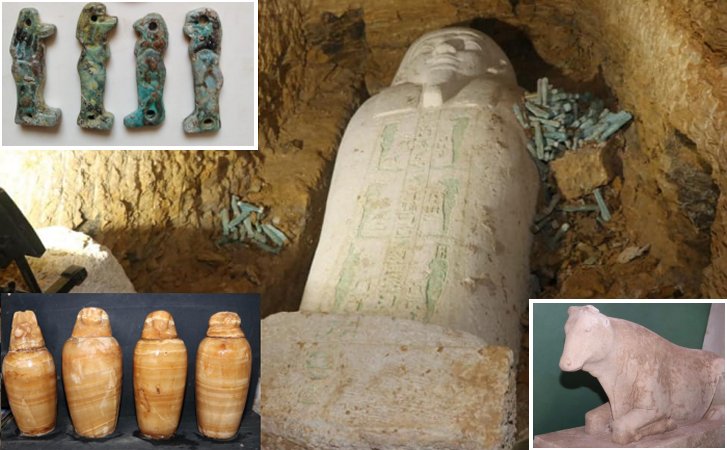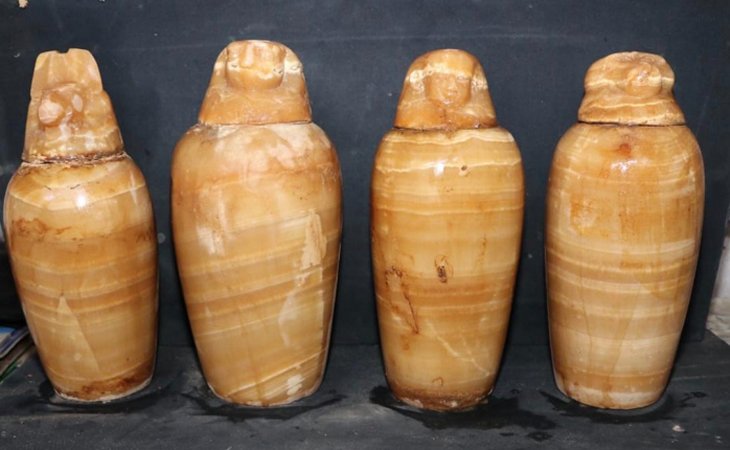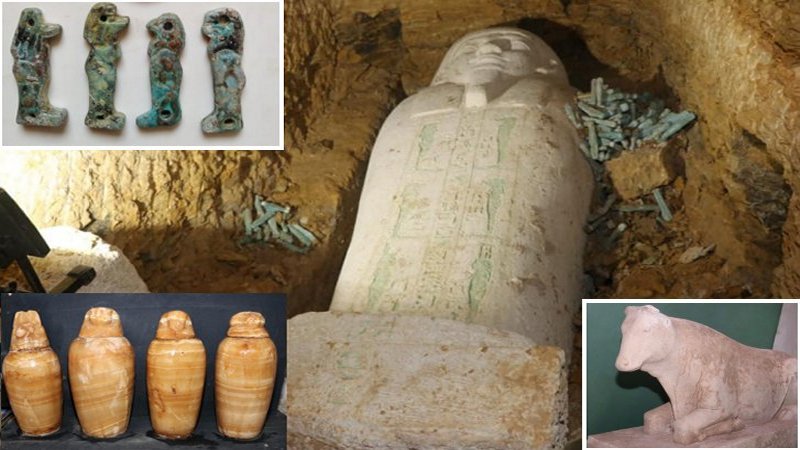Jan Bartek – MessageToEagle.com – There seems to be no end to archaeological findings in Egypt. Archaeologists announced they have found hundreds of marvelous ancient Egyptian treasures when they opened the tombs in Minya.

The Ancient Tomb Of Royal Supervisor Badi Est
One of the tombs belonged to a royal supervisor named Badi Est.
While excavating in an area of Al-Ghuraifah, in Minya Governorate’s Tuna Al-Jabal, an Egyptian team of archaeologists discovered a well-preserved tomb that belonged Badi Est, a Supervisor of the royal treasury.
The tomb consists of a burial well that is ten meters deep, leading to a large room with niches engraved in the rock and closed with regular stone slabs, said the Secretary General of the Supreme Council of Antiquities and Head of the Mission Mostafa Waziry.

Canopic jars were found inside the tomb of Badi Est. Credit: Ministry of Tourism and Antiquities
When scientists opened the tomb, they saw it was filled with precious artifacts clearly indicating the deceased man was wealthy and enjoyed a high social status.
As many as 400 blue and green Ushabti figurines bearing the name of the deceased were placed in his tomb. “Ushabti were servants devoted to working for their deceased owners. In ancient Egyptian religion, the tombs were equipped with small-sized and mummy-shaped figurines with arms crossed on the chest. The use of them was widespread, and their ‘mission’ was to set the deceased free from the necessity of labor in the afterlife.! 1
According to the Ministry of Tourism and Antiquities, archaeologists also found six burials of his family members containing nearly 1,000 Ushabti statuettes.
Ministry of Tourism and Antiquities
Inside this magnificent burial, there were also two limestone statues, one of which is in the shape of the Apis calf, and the other is in the shape of a woman.
See also:
Amulets, Figurines Discovered In Recently Unearthed Limestone Sarcophagus In Minya, Egypt
This came in addition to alabaster canopic jars in the form of the four sons of Horus and engraved with the titles and names of the deceased.
Ancient Egyptians followed all rules required in order to ensure an afterlife. It was custom to place canopic jars inside the burial. “Canopic jars were ritual vessels containing internal organs removed from the body of the deceased during the mummification process.” 2
The four sons of Horus were “guardians of the internal organs of the deceased, they were very important for the burial ritual. Each one was associated with a particular organ and a different cardinal point on the compass.” 3
Statue of a bull found inside the tomb of Badi Est. Credit: Ministry of Tourism and Antiquities
In addition to all these ancient treasures, archaeologists also found four intact stone sarcophagi, amulets, scarabs, and a set of utensils, as well as pottery from the Sawy era that ruled ancient Egypt from the 26th to the 30th Dynasties.
The Ancient Sarcophagus Of Egyptian High Priest
Earlier this year, archaeologists excavating in Minya found 16 ancient Egyptian tombs containing 20 sarcophagi (some of them decorated with hieroglyphics), coffins, and other artifacts from a vast burial ground. One of the sarcophagi belongs to the ancient Egyptian God Thoth’s high priest.
Sarcophagus of a man named “Jehuti Imhotep”, the chief priest of ancient Egyptian god Jehuti. Credit: Ministry of Tourism and Antiquities – Read more
Scientists will keep working in the area and it’s safe to assume we will soon learn more about new astonishing discovered mand in the land of the pyramids.
Written by Jan Bartek – MessageToEagle.com – AncientPages.com Staff Writer
Expand for references- Sutherland – Ushabti: Servants Who Worked For Their Owners In Afterlife In Ancient Egyptian Beliefs, AncientPages.com
- Sutherland – Canopic Jars: Funerary Tradition Of Ancient Egyptians And Their Beliefs In Afterlife, AncientPages.com
- Ellen Lloyd – The ‘Four Sons Of Horus’ And Their Connection To Stars In The Ursa Major Constellation, AncientPages.com







